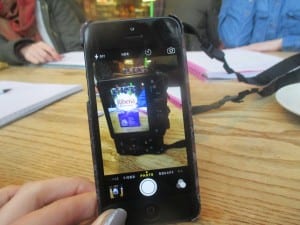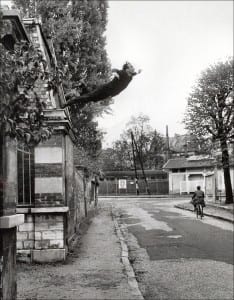Whilst exploring Philip Auslander’s The Performativity of Performance Documentation, it made me begin to question what really counts as a ‘performance’. He splits performance documentation into two types: Theatrical and Documentary. Auslander describes ‘documentary’ performance as the traditional way of performance art – being performed there and then, with people witnessing or recording it actually happening. However, ‘theatrical’ is almost the second hand performance. Although in the final performance documentation, it may look real – this type of performance is staged to look as if it really happened, but actually didn’t happen. Only in the final documentation (the photograph) is when you can see something happening. This made me think of our present day society. How do we know what is really real, with editing apps such as photoshop and green screen to make film settings and imagery look more enhanced? What is the original picture or performance art – taking the original photo, or adding to it to make it something different? The power of photography and camera works is something that particularly stands out to me.
Auslander uses two performance art works by practitioners Chris Burden and Yves Klein as evidence of these two classifications. Chris Burden’s 1971 performance art named ‘Shoot’, fits into the category of ‘documentary’ performance/body art. In this performance, Chris Burden is shot in his left arm and we can visually see and hear him being shot on the recording. (Waldir Barreto, 2008). Although it is clear he was definitely shot, who are his intended audience? The people who were present at the onset of the recording, or us, the viewers watching through the recording? In this sense, body art performance works needs the photograph to confirm its having happened: it is an ‘anchor for its indexicalities.’ (Auslander, -). Without the recording, Burden would only have the people present at the time to vouch for the shooting happening. Secondly is that of Yves Klein’s ‘theatrical’ performance documentation called ‘Jumping into the Void‘. In this performance art, Klein intended to generate a piece of art which would have some sort of ‘social impact of mass media as a means of persuasion.’ (Zone Zero, -).
Klein was actually only falling onto a padded matt beneath him and then the photograph was edited to put the outside photo with the upper part of the photo. This is why it is so contrasting to see the man on the bike acting so casually. This photo can completely alter someone’s view of that space and time. As stated by Klein, he believes that ‘man will only be capable of conquering space after impregnating it with his own sensitivity.’ (Klein, 1961.)
When using this knowledge of what is the real, authentic act of the performance, Auslander talks about audio recordings, using The Beatles as an example. When they record their music, the instruments do not always play with them, they play separately and are then added together to make layers of music that mould together to make one. Therefore he makes the reader question whether the music we listen to really is true or authentic. During one of our sessions, our group decided to use these theories as a possibility for performance work, playing with the idea of complexities of photo’s within photo’s. Whilst sat in the cafe, we took this photo using multiple devices, which could then possibly carry on if people were to take a photo of ours and so forth. Here was our experiment in performance documentation: 
Works Cited:
Auslander, P. (-) The Performativity of Performance.
Waldir Barreto (2008) Chris Burden : Shoot, 1971. [online video] Available from: https://www.youtube.com/watch?v=JE5u3ThYyl4 [Accessed 12 February 2015].
Zone Zero (-) Jumping into the Void. [online]. Available from: http://v1.zonezero.com/magazine/zonacritica/saltaralvacio/index.html [Accessed 12 February 2015.]

